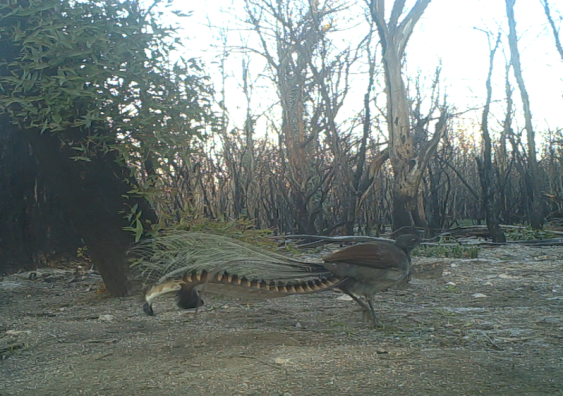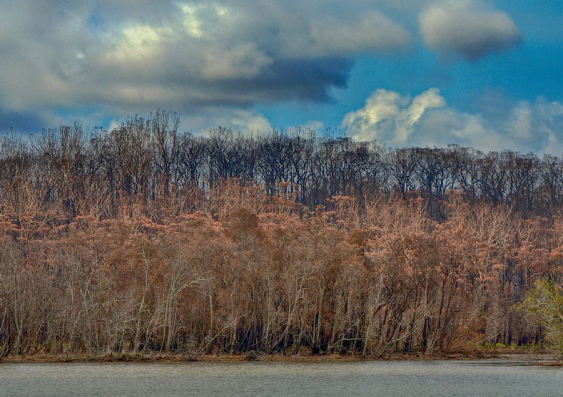The Black Summer Bushfires burnt an unprecedented area of over 5 million hectares of eastern Australia, with severe economic, environmental, and human impacts. Now, a study conducted by UNSW Sydney researchers shows plant and animal life has struggled to rebound in locations subjected to the most severe fires.
The study, published in the journal Global Change Biology, analysed differences in species diversity in the aftermath of the 2019-2020 bushfire season in New South Wales. The researchers found that up to 18 months post-fire, biodiversity can recover after fires of low to high severity (when fires burnt the understorey and scorched or partially consumed the canopy) – and did increase a year and a half after the Black Summer Bushfires. However, areas burnt by fires of extreme severity (when fires completely consumed the canopy) experienced reduced levels of biodiversity compared to unburnt and other less severe burnt regions.
Associate Professor Will Cornwell, senior co-author of the study from the School of Biological, Earth & Environmental Sciences, says the findings highlight the fire adaptations of Australian fauna and flora, but also that these adaptations have limits.
“Fire can have both positive and negative effects on biodiversity, and the context is crucial,” A/Prof. Cornwell says. “For example, many Australian species can persist, even with very high severity fires, but some species may struggle when extreme fire severity occurs over large scales.”
Simon Gorta, lead author of the study and a PhD candidate at the UNSW Centre for Ecosystem Science, says the research will help scientists and conservation managers understand which animal and plant species may be impacted by future fires, and identify the areas most needing monitoring and management.
“Our findings illustrate the extent and severity that fires can reach under extensive drought and above-average temperatures, conditions typical of climate change projections,” Mr Gorta says. “As we grapple with the effects of these events on lives and property, we should also be concerned about how our wildlife and ecosystems respond, and how this can be better managed.”

A Superb Lyrebird (Menura novaehollandiae) wanders through burnt forest. These birds can opportunistically exploit recently burnt areas for foraging, but longer-term impacts on their breeding and populations are unclear. Photo: Paula Boer (CC BY-NC).
Differing post-fire recovery regions
For the study, the researchers used tens of thousands of wildlife observations of multiple groups of invertebrates, plants, and vertebrates collected by citizen scientists as part of the Environment Recovery Project and the iNaturalist platform to investigate how biodiversity has recovered after the fires and how the type of fire is essential for determining recovery trajectories.
“This initiative was critical, as long-term biodiversity monitoring data covering multiple groups of organisms, such as plants, insects, birds, and more, especially at the scale of these mega-fires, does not exist outside of citizen science data,” Mr Gorta says. “These data allow us to draw conclusions about the overall effects of these events and determine conservation and management approaches for post-fire recovery.”
Read more: Thousands of native plants are unphotographed, and citizen scientists can help fill the gaps
Overall, the researchers discovered species diversity increased in burnt regions compared to before the fires in both burnt and unburnt parts. But, compared to unburnt regions, species diversity significantly decreased in areas exposed to extreme fire severity.
“The increase in species diversity, or richness, in burnt areas was greater than the increase after fires in unburned areas, which suggests they can recover well if fires are not too severe,” A/Prof. Cornwell says. “But pushing them into this high severity zone has the opposite effect on biodiversity.”
“Many Australian species can persist, even with very high severity fires, but some species may struggle when extreme fire severity occurs over large scales.”
The researchers say they’re not sure whether or when diversity in the extreme severity regions will fully recover.
“We don’t have the data yet to know whether diversity will bounce back – a lot will depend upon whether they burn again with the same intensity in upcoming fire seasons,” A/Prof. Cornwell says. “It implies that in the immediate post-fire aftermath, we need to focus our efforts on supporting recovery in areas that were subject to the highest severity burns.”

Burnt region of southern New South Wales after the 2019-2020 fires. Photo: Teresa Bealey (CC BY-NC-4.0).
In addition to the findings at the biodiversity scale, the study also identified how species with post-fire recovery mechanisms can drive response patterns, particularly for plant species. For example, plants with limited resprouting capacity after severe fires in rainforests are particularly vulnerable to increasingly frequent and intense fires.
“The study highlighted adaptations such as fire-cued flowering, which is a key part of the life cycle of many Australian native plants, potentially increased the detectability and attractiveness of plants in the post-fire environment,” says Dr Mark Ooi, co-author of the study. “This provides both an understanding of the post-fire patterns we see and highlights some of the challenges in surveying biodiversity after these events.”
Read more: Rainforest birds in decline in Black Summer bushfire aftermath
The researchers plan to conduct further studies monitoring different post-fire impacts, including which species are most at risk. They say the efforts of citizen scientists to capture observations represent not only a critical data resource but also reflect the willingness of the public to participate in science to protect the environment.
“Fire seasons are only going to worsen under the current climate projections,” Mr Gorta says. “We need amateur scientists to help grow the dataset further so we can continue to monitor and manage the environmental impacts of wildfires in a rapidly warming and fire-conducive climate.”
